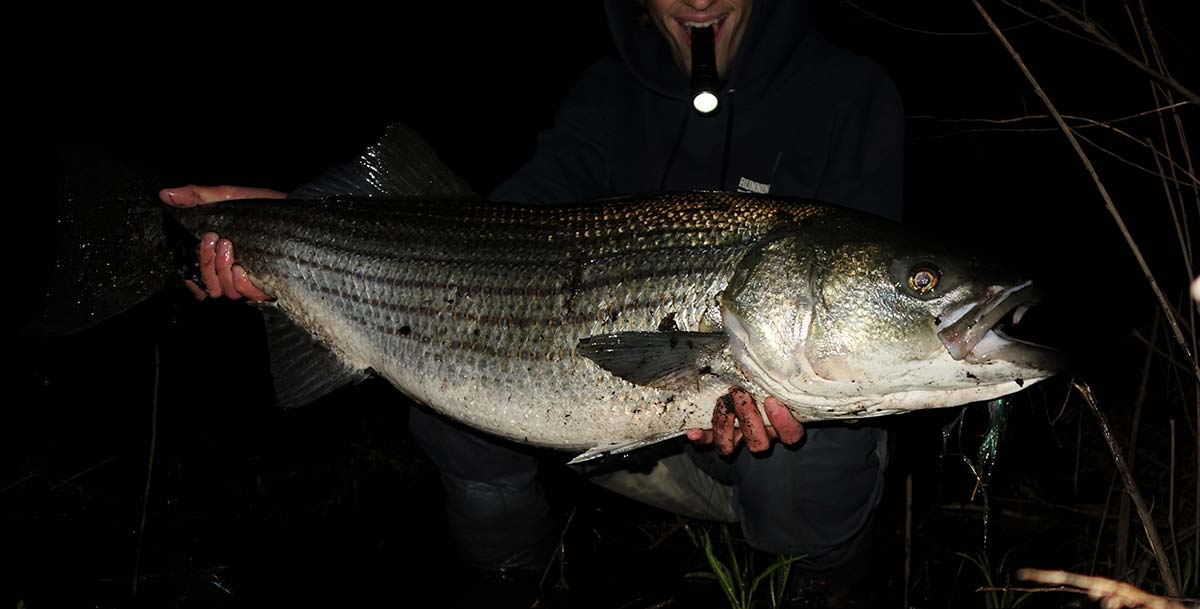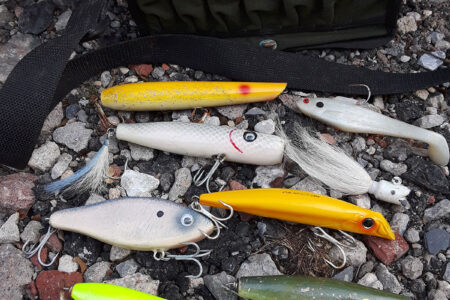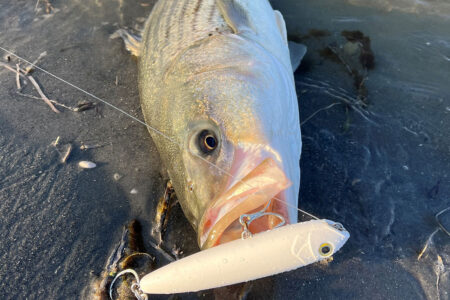
Hooking large bass on the fly requires ‘all-in’ dedication, regular practice and, maybe just a little, luck.
The idea of catching a large striped bass is almost mythical for those dedicated exclusively to the long rod. It’s a lofty goal, catching a cow striper. Limiting yourself to where you can get to on foot already decreases the odds. Reducing the water you can cover down to what you can reach with a fly cast decreases the odds even further. Sometimes it starts to feel like a pipe dream, with endless fishless nights piling up. Friends share photos of large bass they caught casting plugs while you toil away trying to just get that one fish on the fly. There are just a handful of ways to improve your odds.
Perhaps the largest handicap to fly fishing the surf is casting distance. Most fly casters can’t turn out much more than 70 feet of line. Improving your casting can put you a few steps ahead. Maximize efficiency; make fewer false casts and put the most power into the final haul and forward stroke. Experiment with different lines as well, each rod and caster has their own sweet spot. Practice harder than you think you need to. That said, even the best fly casters in the world can’t really hold a candle to even an average cast with a surf rod. It’s often best to narrow your focus to locations where the fish will be within reach. Though it isn’t really the default, cow bass will occasionally close the gap and be right at your feet, or at least make their way within the range of a 90-foot fly cast. Certain shore structures and situations make bigger bass more comfortable in the shallows and in tight. Quick, easy access to deep water, strong current, and the presence of abundant and large bait are all key factors.
Focusing specifically on large bait is a quick way to shorten the curve. Fly casters love small bait, easily imitated with small and simple flies that are easy to cast. But big bass are often looking for more bang for their buck. River herring, bunker, squid, Atlantic mackerel, snapper bluefish, and Atlantic herring all draw large bass. Putting together the conditions that drive these large baits against a shoreline is key, because they need to be almost at your feet. Fly casting in heavy wind and surf can be immensely intimidating, but can also prove fruitful when wind and tide push large bait tight to the shoreline. The behavioral patterns of those baits, such as spawning or feeding, can also drive them into shorelines, rivers, or over flats. Logging data and observations on each outing will allow these patterns to clarify.
The flies themselves are, unsurprisingly, an important aspect. The hooks they are tied on need to be strong and ‘sticky sharp’. There’s no reason to leave a dull-hooked fly on. It’ll surely lose purchase in that crucial moment when a cow takes the fly. Gamakatsu sl12s and Owner Aki’s are some of the best hooks to tie big bass flies on. Flies such as Sedotti’s Slammer, Popovics’ Bulkhead Hollow Fleye, Tabory’s Snake Fly, and large Game Changers have broad utility matching large baits. It’s important to carry a good variety of flies big and small, though, as the very night you’re expecting to catch on big flies will be the night there’s a crazy frenzy on cinder worms. Expect the unexpected, big bass do odd things.
How the fly acts in the water is almost more important than the pattern itself. In daylight, erratic action is often very effective. Rather than a steady two hand retrieve of even cadence strip, try making very long, fast strips with pauses. Make the fly dart wildly and act unpredictably. At night the polar opposite is often best. Rather than stripping at all, find the current and swing your fly. The current itself does all the work. Big bass are often lazy and won’t over-analyze the fly like they sometimes do in daylight. The slower the fly moves, the better. If the current isn’t strong enough to swing, make retrieves deathly sluggish. It often seems tedious, but when that once-in-a-lifetime fish breaks the monotony it suddenly feels right. Set the hook and set it hard.
Perhaps the biggest thing you need to remember is that this is never going to be easy. You have to commit, you can’t be half in. Pick up an 11 or 12wt and a wallet of big flies and then hunt until the goal is accomplished.



